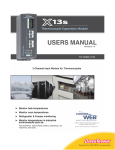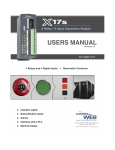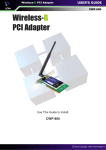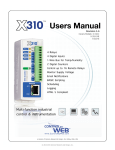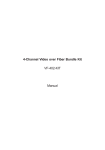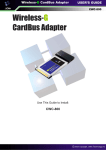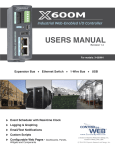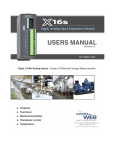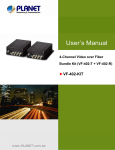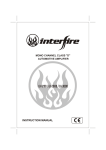Download X-11s Users Manual
Transcript
X-11s™ Users Manual X-11s User Manual Revisions Revision Description 1.0 Page 2 Initial release Xytronix Research & Design, Inc. X-11s™ Users Manual Introduction Section 1: Introduction The X-11s™ 2-relay expansion module is used in conjunction with the X-600M™ controller. The X-11s has two high-current relays. Both relays have Form-C contacts (SPDT). A rugged, high-current connector provides connections to the relays. One or more X-11s expansion modules can be connected to a X-600M control module with a ribbon cable. The ribbon cable provides both power and communications to the expansion modules. The X-600M is a multifunction web-enabled industrial I/O controller. It performs control, logic, and monitoring functions similar to that of a Programmable Logic Controller (PLC). However, unlike a PLC, the X-600M is designed for web-based applications from the ground up. No add-on software or hardware is required. The X-600M can be fully configured, programmed and tested using its built-in web server. The web setup pages are intuitive and easy to use and do not require special programming skills. The X-600M together with expansion modules such as the X-11s provide an easy, flexible and reliable way to monitor and control systems and devices over a network. The X-11s is suitable for use with loads which require line voltages and high current such as pumps, motors, lights and heaters. 1.1 Connectors & Indicators Relays The X-11s has two, high-current, line-voltage-rated relays. It has a large, 6-position plug-in screw terminal connector that provides connections to the relays. The connector can be released by pushing the two orange latches forward, then pulling on the connector housing while squeezing the latches. Terminals are provided for the Common, Normally Open, and Normally Closed contacts. The connector terminals are wired directly to the internal relays with no internal fuse or other over current protection. The relays are isolated from all other circuits inside and from each other. When a relay coil is energized, the NO (Normally Open) contact is closed and the NC (Normally Closed) contact is open. The load device that is connected to the relay contacts may be on or off when the coil is energized depending on which contacts are connected to the load. Expansion Bus The expansion bus allows for a family of expansion modules to be connected directly to the X-600M without the need for an Ethernet switch. The cable can be a daisy chain with multiple connectors. The Xytronix Research & Design, Inc. Page 3 Introduction X-11s™ Users Manual ribbon cable expansion bus provides both power and communications connections. Power Supply The expansion bus can provide up to 1.7 Amps for powering up to 32 expansion modules; however, the maximum number of expansion modules depends on the module type and power source attached to the X-600M. The X-11s requires relative high current to operate the relays and the 1.7 Amp limit will be reached before the 32-module limit. The X-11s employs modern switch-mode power supply. With this type of power supply the current draw decreases as the voltage increases; therefore, you can add more expansion modules by using a 24-volt power supply than you can with a 12-volt power supply. See the X-600M User Manual for more details. Indicators The green, power LED indicator is illuminated whenever the module is powered. To identify the module during installation, the X-600M can send a blink command which will cause the power LED to blink for three seconds. The two, yellow LEDs indicate the status of the relays - Each LED illuminates when its respective relay coil is energized. 1.2 Part Numbers and Accessories Page 4 Device Description Part Number X-11s 2-Relay expansion module X-11s Spare Connector 6-position, screw terminal connector with latches X-1778104 Xytronix Research & Design, Inc. X-11s™ Users Manual Installation and Connections Section 2: Installation and Connections Installation consists of mounting the X-11s and connecting it to an X-600M controller with a 10-conductor ribbon cable. Programming and testing is done by using a web browser to configure the web pages, inputs, and outputs for your specific needs. 2.1 Installation Guidelines • This unit must be installed by qualified personnel. In the case of line-voltage connections, a licensed electrician should be employed. • This unit must not be installed in unprotected outdoor locations. • This unit must not be used for medical, life saving purposes, or for any purpose where its failure could cause serious injury or the loss of life. • This unit must not be used in any way where its function or failure could cause significant loss or property damage. This equipment is tested to UL 61010-1 safety requirements for equipment to be supplied from the building wiring (i.e. thru a circuit breaker). It is not rated for installation within or as part of the circuit breaker panel. When used to control AC line voltages, the X-11s must be mounted and protected in a suitable electrical enclosure. 2.2 Mounting The X-11s can be mounted to a standard (35mm by 7.55mm) DIN-Rail. Normally expansion modules are mounted to the left side (embossed logo side of the enclosure) of the X-600M controller so that the ribbon cable doesn't cover the power connector. The X-11s should be located in a clean, dry location where it is protected from the elements. Ventilation is recommend for installations where high ambient air temperatures are expected to be high. See Appendix D: Mechanical Information for additional mechanical details. 2.2.1 DIN-Rail Mounting Attach the X-600M to the DIN-Rail by hooking the top hook on the back of the enclosure to the DIN-Rail and then snap the bottom hook into place. To remove the X-600M from the DIN-Rail, use a flat-head screwdriver. Insert the screw driver into the notch in the release tab and pry against the enclosure to release the bottom hook. Xytronix Research & Design, Inc. Page 5 Installation and Connections X-11s™ Users Manual 2.3 Making Connections CAUTION: Make sure the power is shut off before making connections CAUTION: This unit should be installed by a qualified technician. CAUTION: Miswiring or misconfiguration could cause permanent damage to the X-11s, the equipment to which it is connected, or both. 2.3.1 Connecting the X-11s to the Expansion Bus Connect the X-11s to the expansion bus using a ribbon cable (sold separately). The number of modules that are connected to the expansion bus are dependent upon the type of module, the power supply used, and the number and type of other modules connected to the expansion bus. This can be calculated by adding up the total amount of current required for each module (with all relays, inputs, etc. on) at the voltage provided by the power supply. That number is called the expansion bus current (make sure the expansion bus current does not exceed 1.7 Amps). Next, add the expansion bus current to the current required by the X-600M. That is the total current required. Make sure the power supply used has an output current rating that is higher than the total current required. Some extra margin is recommended. For example, using the 24V 1.75Amp power supply that we offer: At 24V, the X-600M draws 80mA which leaves 1.67A for the expansion bus (1.75A - 0.080A = 1.67A). Each X-11s module requires up to 105mA at 24V. If we divide 1.67A by 0.105A we get 15.9A. This means … With a 24V, 1.75A power supply, the maximum number of X-11s expansion modules that can be connected to the expansion bus is 15 (with no other types of expansion modules connected). Note: A larger power supply and power injectors can be used to attach more modules to the bus (see the X-600M users manual for details). 2.3.2 Connecting Relays A removable terminal connector is provided for making the power connections. The correct wiring procedure is as follows: 1. Make sure power is turned off. 2. Remove the terminal connector from the X-11s and make wiring connections to the terminals. This technique avoids stressing the internal components while torquing the screws. 3. Reconnect the terminal connector. 4. Apply power. It is recommended that any load (device to be controlled) not be connected to the expansion modules until after the X-600M has been configured and tested. By doing this, wiring and configuration mistakes will not cause the load device to turn on unexpectedly. Make certain the wires are properly inserted into to the terminals and that the screws are tight. Page 6 Xytronix Research & Design, Inc. X-11s™ Users Manual Installation and Connections Wire Specification: Use wire rated for 90ºC (min) for connections to the terminal blocks Connector Specifications: Type: Stripping Length: Connection capacity: Conductor minimum: Conductor maximum: Conductor Type: Tightening torque: Xytronix Research & Design, Inc. 6-position, removable, 7.62 mm pitch, with tool-free snap-lock latches 10mm 6mm2 stranded, 10mm2 solid 24AWG (UL/CUL) 8 AWG (UL/CUL) Copper 0.5 Nm (min), 0.8 Nm (max) Page 7 Example Applications X-11s™ Users Manual Section 3: Example Applications 3.1 Control a device over an IP network The illustration below shows a simple example of how to use the X-11s to control a device over an IP network. The device to be controlled is wired in series with the relay contacts. Note: A fuse or circuit breaker is shown to limit current overload. 3.2 High Current Relay The illustration below shows an example of how the X-11s is used to control an AC motor. A high-current relay is used to switch the load current to the motor. In this example a MOV (Metal Oxide Varistor) is used to help protect the relay contacts of the X-11s from arc damage. Under normal conditions the resistance of the MOV is very high. When a spike or surge occurs the resistance of the MOV drops and shunts the high voltage transients. Page 8 Xytronix Research & Design, Inc. X-11s™ Users Manual Configuration and Setup Section 4: Configuration and Setup 4.1 Setup Example The Quick Start Demo After making the power and Ethernet connections, the X-600M can automatically scan for the presence of any ControlByWeb™ Ethernet devices (on the same sub-net) and also for any expansion modules connected to the X-600M via the ribbon-cable connector. It also automatically creates a dashboard web page and populates it with all of the resources (components) supported by the Ethernet devices and expansion modules. This makes it easy to start experimenting with the web page's user interface and to try out the relays and sensors. To quickly add a device do the following: 1. Click on the Devices menu tab to pull up the Devices Overview page. Then click on the Find New Devices button to scan the expansion bus and the local network for ControlByWeb devices and expansion modules. 2. In this example we are going to add an X-11s | 2 Relay expansion module. Click the Add button for the X-11s. Xytronix Research & Design, Inc. Page 9 Configuration and Setup X-11s™ Users Manual 3. In the Select column, click the checkboxes of the I/O components you would like to configure and select the Create Device Widget checkbox (This will display the status of the I/O on the Dashboard). Click Add Checked I/O to submit these changes. 4. Click Commit Settings - Once clicked, the X-600M begins to monitor the newly added device. Page 10 Xytronix Research & Design, Inc. X-11s™ Users Manual Configuration and Setup 5. On the main menu, click the View Dashboards menu tab. The View Dashboards page shows a display similar to what users will see when accessing the X-600M's control page. A button and status display for both relays should appear. Use this page to test and debug the dashboards, panels, widgets and components in real time. A pulldown menu allows access to other dashboards. Within minutes you can experience the power and flexibility of the dashboard's user interface and experiment/test the buttons, sliders, and data entry boxes to meet your needs for your specific application. Xytronix Research & Design, Inc. Page 11 Appendix A: Specifications X-11s™ Users Manual Appendix A: Specifications Power Requirements Input Voltage: 9-28 VDC (power is supplied via the X-600M controller, 24V recommended) Current: See table below for typical values at 25°C Power Supply Relays OFF Relays ON 9 VDC 15 mA 260 mA 12 VDC 12 mA 196 mA 24 VDC 7 mA 105 mA Relays Number of relays: 2 Relay Contacts Load Type: Contact Form: Contact Material: Max Voltage: General purpose SPDT (form 1C) Silver Nickel 277 VAC (general purpose) 30 VDC (NC contact, resistive) Max Current: 20A Electrical Life: 100K cycles, typical @ full rated load (higher with smaller load) Mechanical Life: 10M cycles, typical Environmental Rating: Over voltage Category II, Pollution Degree 2 Control Options: Pulse Timer Duration: On/Off or Pulsed 100ms to 86400 Seconds (1-day) Relay Connector Type: Connection wire: Stripping Length: Connection capacity: Conductor minimum: Conductor maximum: Conductor Type: Tightening torque: 6-position, removable, 7.62 mm pitch, with tool-free snap-lock latches Use wire rated for 90ºC (min) for connections to the terminal blocks 10mm 6mm2 stranded, 10mm2 solid 24AWG (UL/CUL) 8 AWG (UL/CUL) Copper 0.5 Nm (min), 0.8 Nm (max) (Replacement part number, Phoenix Contact 1778104) Expansion Connector: Connector: Communications: Ribbon cable, 2x5-position, polarized 0.100” pitch RS-485 LED Indicators Green: Yellow: Power On Relay1, Relay 2 Environmental Indoor use or NEMA-4 protected location Altitude: up to 2000m Page 12 Xytronix Research & Design, Inc. X-11s™ Users Manual Appendix A: Specifications Operating Temperature: Storage Temperature: Humidity: -40ºC to 65.5ºC (-40ºF to 150ºF) -40ºC to 85ºC (-40ºF to 185ºF) 5-95%, non-condensing Mechanical Size: Weight: 1.41 x 3.88 x 3.1 in. (35.7 x 98.5 x 78 mm), (not including connector) 4.8 oz (136 g) Electromagnetic Compliance IEC CISPR 22, CISPR 24 CC 47CFR15 (Class B) EN55024 ITE Immunity (2010) EN55022 Emissions (2010) Product Safety Compliance UL 61010-1 (Electrical Equipment for Measurement, Control, and Laboratory Use) Xytronix Research & Design, Inc. Page 13 Appendix B: Trademark and Copyright Information X-11s™ Users Manual Appendix B: Trademark and Copyright Information This document is Copyright ©2014 by Xytronix Research & Design, Inc. All rights reserved. X-600M™, WebRelay™, ControlByWeb™, and Xytronix Research & Design™ are trademarks of Xytronix Research & Design, Inc. 2005-2014. All other trademarks are the property of their respective owners. All parts of this product and design including but not limited to firmware, hardware design, schematics, PCB layout, concept, graphics, users manual, etc., are property of Xytronix Research & Design, Inc. ©2005-2014. X-600M may not be opened, disassembled, copied or reverse-engineered. No part of this manual may be reproduced or transmitted in any form or by any means, electronic or mechanical, including photocopying or scanning, for any purpose other than the personal use by the purchaser of this product. Xytronix Research & Design, Inc., assumes no responsibility for any errors that may appear in this document. Whereas reasonable effort has been made to make the information in this document as useful and accurate as possible, Xytronix Research & Design, Inc. assumes no responsibility for the application, usefulness, or completeness of the information contained herein. Under no circumstance will Xytronix Research & Design, Inc. be responsible or liable for any damages or losses including direct, indirect, special, incidental, or consequential damages or losses arising from either the use of any information contained within this manual or the use of any products or services referenced in this manual. Xytronix Research & Design, Inc. reserves the right to change any product’s features, specifications, documentation, warranties, fee schedules, and conditions at any time and without notice. Page 14 Xytronix Research & Design, Inc. X-11s™ Users Manual Appendix C: Warranty Appendix C: Warranty This Xytronix Research & Design, Inc. product has a warranty against defects in material and workmanship for a period of one year from the date of shipment. During the warranty period, Xytronix Research & Design, Inc. will, at its option, either repair or replace products that prove to be defective. This warranty is extended to the original purchaser of the equipment only. For warranty service or repair, the product must be properly packaged, and returned to Xytronix Research & Design, Inc. The purchaser shall prepay all charges for shipping to Xytronix Research & Design, Inc., and Xytronix Research & Design, Inc. will pay the shipping charges to return the product to the purchaser as long as the product is shipped within the United States. If the product is shipped outside of the United States, the purchaser shall pay all shipping charges, duties, and taxes. Limitation The foregoing warranty shall not apply to defects or damage resulting from improper use or misuse, unauthorized repair, tampering, modification, improper connection, or operation outside the electrical/environmental specifications for the product. Further, the warranty does not cover Acts of God, such as fire, flood, hurricanes, and tornadoes. This warranty does not cover damage to property, equipment, direct, indirect, consequential, or incidental damage (including damage for loss of business profit, business interruption, loss of data, and the like) arising out of the use or misuse of this product. UNDER NO CIRCUMSTANCES WILL THE LIABILITY OF XYTRONIX RESEARCH & DESIGN, INC. TO THE PURCHASER OR ANY OTHER PARTY EXCEED THE ORIGINAL PURCHASE PRICE OF THE PRODUCT, REGARDLESS OF THE FORM OF THE CLAIM. No other warranty is expressed or implied. Xytronix Research & Design, Inc. specifically disclaims the implied warranties or merchantability and fitness for a particular purpose. Some jurisdictions may not allow the exclusion of limitation of liability for consequential or incidental damage. Xytronix Research & Design, Inc. Page 15 Appendix D: FCC Statement X-11s™ Users Manual Appendix D: FCC Statement This device complies with Part 15 of the FCC Rules. Operation is subject to the following two conditions: - This device may not cause harmful interference. - This device must accept any interference received, including interference that may cause undesired operation. Warning This equipment has been tested and found to comply with the limits for a Class B digital device, pursuant to Part 15 of the FCC Rules. These limits are designed to provide reasonable protection. This equipment generates, uses and can radiate radio frequency energy and, if not installed and used in accordance with the instructions, may cause interference to radio communications. There is no guarantee, however, that interference will not occur in a particular installation. If this equipment does cause harmful interference to radio or television reception, which can be determined by turning the equipment off and on, the user is encouraged to try to correct the interference by one or more of the following measures: - Reorient or relocate the receiving antenna. Increase the separation between the equipment and receiver. Connect the equipment into a relay on a circuit different from where the receiver is connected. Consult the dealer or an experienced radio/TV technician for help. Notice Changes or modification not expressly approved by the party responsible for compliance could void the user’s authority to operate the equipment. Page 16 Xytronix Research & Design, Inc. X-11s™ Users Manual Appendix E: Mechanical Dimensions Appendix E: Mechanical Dimensions Xytronix Research & Design, Inc. Page 17


















